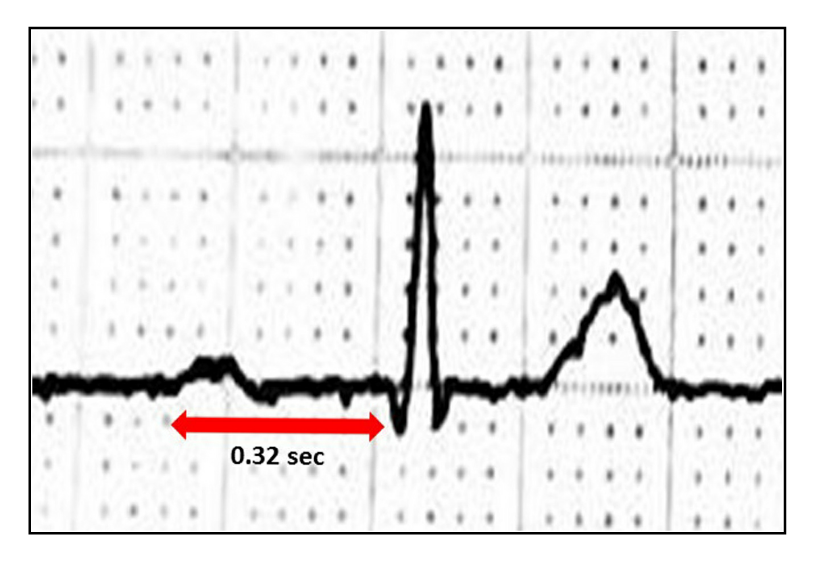[1]
Lewalter T, Pürerfellner H, Ungar A, Rieger G, Mangoni L, Duru F, INSIGHT XT study investigators. "First-degree AV block-a benign entity?" Insertable cardiac monitor in patients with 1st-degree AV block reveals presence or progression to higher grade block or bradycardia requiring pacemaker implant. Journal of interventional cardiac electrophysiology : an international journal of arrhythmias and pacing. 2018 Aug:52(3):303-306. doi: 10.1007/s10840-018-0439-7. Epub 2018 Aug 13
[PubMed PMID: 30105427]
[2]
Lee S,Singla M, An Unrecognized Rash Progressing to Lyme Carditis: Important Features and Recommendations Regarding Lyme Disease. American journal of therapeutics. 2016 Mar-Apr
[PubMed PMID: 25730155]
[3]
Nikolaidou T,Ghosh JM,Clark AL, Outcomes Related to First-Degree Atrioventricular Block and Therapeutic Implications in Patients With Heart Failure. JACC. Clinical electrophysiology. 2016 Apr
[PubMed PMID: 29766868]
[4]
van Stigt AH,Overduin RJ,Staats LC,Loen V,van der Heyden MA, A Heart too Drunk to Drive; AV Block following Acute Alcohol Intoxication. The Chinese journal of physiology. 2016 Feb 29
[PubMed PMID: 26875557]
[5]
Rojas LZ,Glisic M,Pletsch-Borba L,Echeverría LE,Bramer WM,Bano A,Stringa N,Zaciragic A,Kraja B,Asllanaj E,Chowdhury R,Morillo CA,Rueda-Ochoa OL,Franco OH,Muka T, Electrocardiographic abnormalities in Chagas disease in the general population: A systematic review and meta-analysis. PLoS neglected tropical diseases. 2018 Jun
[PubMed PMID: 29897909]
Level 1 (high-level) evidence
[6]
Mantovani A,Rigolon R,Pichiri I,Morani G,Bonapace S,Dugo C,Zoppini G,Bonora E,Targher G, Relation of elevated serum uric acid levels to first-degree heart block and other cardiac conduction defects in hospitalized patients with type 2 diabetes. Journal of diabetes and its complications. 2017 Dec
[PubMed PMID: 29033310]
[7]
Cheng S,Keyes MJ,Larson MG,McCabe EL,Newton-Cheh C,Levy D,Benjamin EJ,Vasan RS,Wang TJ, Long-term outcomes in individuals with prolonged PR interval or first-degree atrioventricular block. JAMA. 2009 Jun 24
[PubMed PMID: 19549974]
[8]
Barold SS, Indications for permanent cardiac pacing in first-degree AV block: class I, II, or III? Pacing and clinical electrophysiology : PACE. 1996 May;
[PubMed PMID: 8734740]
[9]
Holmqvist F,Daubert JP, First-degree AV block-an entirely benign finding or a potentially curable cause of cardiac disease? Annals of noninvasive electrocardiology : the official journal of the International Society for Holter and Noninvasive Electrocardiology, Inc. 2013 May
[PubMed PMID: 23714079]
[10]
Tracy CM,Epstein AE,Darbar D,DiMarco JP,Dunbar SB,Estes NA 3rd,Ferguson TB Jr,Hammill SC,Karasik PE,Link MS,Marine JE,Schoenfeld MH,Shanker AJ,Silka MJ,Stevenson LW,Stevenson WG,Varosy PD,Ellenbogen KA,Freedman RA,Gettes LS,Gillinov AM,Gregoratos G,Hayes DL,Page RL,Stevenson LW,Sweeney MO,American College of Cardiology Foundation.,American Heart Association Task Force on Practice Guidelines.,Heart Rhythm Society., 2012 ACCF/AHA/HRS focused update of the 2008 guidelines for device-based therapy of cardiac rhythm abnormalities: a report of the American College of Cardiology Foundation/American Heart Association Task Force on Practice Guidelines and the Heart Rhythm Society. [corrected]. Circulation. 2012 Oct 2
[PubMed PMID: 22965336]
Level 1 (high-level) evidence
[11]
Clowse MEB,Eudy AM,Kiernan E,Williams MR,Bermas B,Chakravarty E,Sammaritano LR,Chambers CD,Buyon J, The prevention, screening and treatment of congenital heart block from neonatal lupus: a survey of provider practices. Rheumatology (Oxford, England). 2018 Jul 1
[PubMed PMID: 30137589]
Level 3 (low-level) evidence
[12]
Georgijević L,Andrić L, Electrocardiography in pre-participation screening and current guidelines for participation in competitive sports. Srpski arhiv za celokupno lekarstvo. 2016 Jan-Feb
[PubMed PMID: 27276869]

